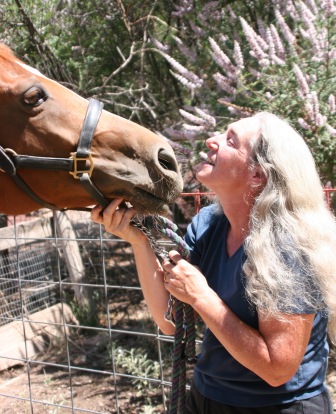Un-natural horsemanship

YEARS AGO I used to edit a publication called The Trail Less Traveled. It was a newsletter with a high subscription price, widely loved by those who had drunk the Kool-Aid of natural horsemanship. As a writer and editor for that publication, I had the good fortune of participating in clinics with Marty Marten and Buck Brannaman and Pat Parelli before they’d written books and made DVDs and hit the clinic circuit.
I have since started a few horses using natural horsemanship methods (and two I sent to natural horsemanship trainers to be started), and my mare, a particularly stubborn loader, is no stranger to the rope halter and stickand- bag method. So know that I write from a position of some knowledge.
There’s a disturbing element to the whole cult of natural horsemanship. And like many cults, it preys on those who are lost in their journey. Many devotees appear to have come to horses later in life, without the benefit of good summer camp programs, Pony Club, or a good lesson stable and trainer. Many just missed out on the basics. Many are fearful to the point of being paralyzed.
Here’s the scenario: Jill Executive lives in New York City but has always dreamed of owning a horse. She quits her job or sells her company, moves West, and buys a horse (maybe off Craigslist). Within a few weeks, the horse (named Chief ) has figured out that Jill doesn’t know how to properly lead a horse, load a horse, or even stay balanced on a horse, and he has dumped, stomped, and otherwise frightened Jill, who continues to handfeed Chief and spoil him.
Chief maybe wasn’t that well trained to begin with, but Jill doesn’t know that. The stomping and tromping continue. Jill gets scared.
Devouring all the information she can find, Jill spends a small fortune on DVDs, books, the rope halter and stick, and signs up for a clinic, maybe enlists the help of a local trainer sanctioned by the Big Name from out of state. Jill and Chief work in the round pen, and the trainer sends them home. They practice, and maybe things get better for Jill. Or maybe not. Jill is now so petrified of Chief that she won’t ride him, and comes to me. She needs to ride one of my nice school horses to get her confidence back.
At this point I’m tempted to tell her that it’s okay to give up. After all, horse ownership isn’t for everyone. It is, I tell her, supposed to be fun. But Jill is determined to fulfill the childhood dream of galloping across the desert on horseback. Only she is so fearful, she may never even trot. If I can just get her out of the round pen at a walk, I’ve accomplished something. So begins Jill’s deprogramming.
“Can I work Bee in the round pen?” “I don’t have a round pen. Bee does not really do natural horsemanship because he leads, loads, and does three tempi changes.”
“I like to do ground work before I ride, you know, just to make sure they are hooked on.”
“Listen, Jill. Why not just get on and see how it goes? I would not put you in any danger. Bee is very well trained, and I’m right here with you.”(Bee, standing in the cross-ties with one leg cocked, eyes closed, would be sawing logs now—if horses snored. If only Jill knew that Bee’s favorite gait is whoa.)
Jill leads Bee to the arena and gets on. She squeezes with her legs and Bee walks. She turns her body to the right, and Bee turns right.
“Chief doesn’t do that. When I squeeze, he just stands there. Although sometimes he bucks. And he doesn’t really stop, either.”
Hopefully Jill and Chief work long and hard enough with the right people—knowledgeable, confidencebuilding horse people who can give Jill a variety of tools and ideas to work with—that this story has a happy ending and Chief doesn’t end up on Craigslist, or worse. Many unhappy horses and frightened riders have not made it past the rope halter and carrot stick.
Here’s why: Good horsemanship is not a recipe. It is not a list of tricks. It is endless trial and error, every day, every ride. It is experimentation, and more than anything, it is time spent with horses in different environments—on the trail, at a horse show, in the arena, and yes, sometimes (but not always) in the round pen. It is hours and hours in the saddle, riding as many different horses as you can. It is mileage. It is developing a toolbox containing a variety of methods gleaned from wise horsemen and women of all stripes.
There most definitely is a place for natural horsemanship in the panoply of horse training tools, but don’t let anyone tell you it’s the only method. Learn, experiment, and get out of the round pen.
Emily Esterson has been writing about horses, business, and the business of horses for two decades. She is the author of The Ultimate Book of Bits and runs a small private eventing and dressage barn in Albuquerque’s South Valley: www.emilyesterson.com
